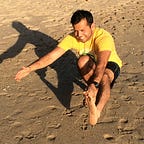CrossFit + Tech?
How will the hardwear revolution reach CrossFitters?
When I think of the phrase “performance analytics”, I think of Ivan Drago throwing punches in this training montage from Rocky IV. Whereas a lot of analytics are used in the realm of an Olympic training center or research institute, the hardwear revolution has already started to make this available for us down at the grassroots level. If the generation and development of these technologies can manage to effectively measure performance without being an annoyance, I can see these sorts of applications start to grow in popularity amongst the CrossFit segment. With the hardware revolution set to expand over the next couple of years, I think there is a high likelihood that high intensity functional fitness training will become increasingly measurable, observable, and repeatable for consumers (and not just people like Ivan Drago).
In the realm of wearable fitness technology, a lot of my peers immediately think of companies such as Jawbone, FitBit, and Nike’s FuelBand. At the end of the day, I don’t see a perceived need for any of these devices for elite athletes — even as a slightly-better-than-middling practitioner of high intensity functional movement, I personally don’t see the long-term value of a device that counts the number of steps I took during the day or measures my energy output via a proprietary algorithm. However, I think there are quite a few emerging applications in the wearable device space that could be useful for amplifying the coach-to-athlete feedback loop in a way that would be useful to me. The Push wearable device as well as Atlas Wearables will both purportedly aid in the analysis of functional movement patterns in a way that Jawbone/FitBit/FuelBand aren’t doing. Combining performance data (such as power, force, speed, and acceleration) with biometric data (heart rate, skin temperature, respiration) in a real-time display can already be delivered to consumers in other sports (cycling and triathlon being the obvious ones), so I don’t think it would be too much of a stretch to see this type of data being used in optimizing fitness training.
Aside from wearables, I think there are a couple of other simple hardwear applications that could be useful for functional fitness training. Nike can already help consumers quantify your performance on a basketball court via sensors implanted in your shoes. There is an incredible potential for this, I think, in the realm of Olympic weightlifting. Having a real-time display of applied force to the ground could absolutely assist coaches in cueing athletes to move efficiently and more powerfully. Another simple set of hardwear devices that intrigue me are coming out of Zepp Labs, who have targeted tennis, golf, and baseball customers. A small device placed on the end of a golf club can clearly have benefits in analyzing swing path and velocity. Put this device on a barbell, and you have bar path and bar velocity, both key measures for an Olympic weightlifting coach.
All of these ideas may be too geeky for some people, and maybe small hardwear devices have no place at a CrossFit affiliate with barbells, chalk, sweat, and (possibly) vomit. There will never be a substitute for an experienced coach or trainer giving you real-time feedback and cues, but the proliferation, low cost, and development of sensors has the potential to change the coaching techniques for athletes at your local gym. I’m keeping my ear to the ground for this in 2014.
- *UPDATE*, December 2015
- Well, it looks like this never really materialized in a big way.
- There have been some incremental improvements in mainstream wearables like Jawbone and FitBit. I have actually started to wear one of these just to track my sleep and general activity data at work, but I wouldn’t ever use it to improve my workouts.
- Atlas and Push never really got to market in a big way in 2014 or 2015, nor has their been a “Zepp” for Oly lifting. Some interesting developments, I think, are in smart apparel (Athos). That will still only cater to a niche set of consumers.
- I don’t think that the “CrossFit” fitness consumer and the mainstream consumer are really that far off, especially given how CrossFit has spawned such a rapid adoption of higher intensity functional fitness training in the entire industry. However, I’ve decided to become a bit bearish on hardware applications for this fitness environment for the near future.
